|
The need for a structure to hold large-scale
gatherings was recognized early-on in planning for the Fair.
By January, 1963, the New York World's Fair Corporation was considering
the construction of a World's Fair Assembly Pavilion. Plans called
for an open-sided structure to be located near the main entrance
of the Fair that would accommodate up to 2,000 people. This building,
designed by the architectural firm of Eggers & Higgins, would
be one of only a few actually constructed by the World's Fair
Corporation.
Plans are nearing completion
for the World's Fair Assembly Pavilion, designed to remain as
a permanent feature of Flushing Meadow Park after the end of the
Fair. The 2,000-seat pavilion is an open-air structure, roofed
to protect audiences from rain and sun; it will have complete
stage facilities and, in addition to free entertainment, will
be available to special convention groups and other large meetings.
Contracts have been signed for weekly Nationality Day Folk Festivals
to take place in this pavilion and for weekly exhibitions of square
dancing representative of the best national dancers and callers.
Other free events will include daily band concerts and various
musical championships.
Source: NY World's
Fair Corporation Progress Report #7, January 24, 1963
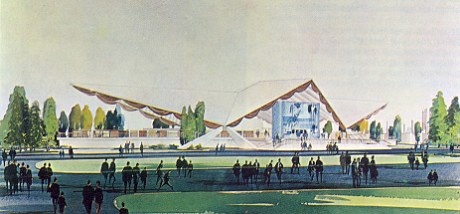 |
In April, 1963, the Fair Corporation began
advertising for a contract for the construction of a much larger,
outdoor facility that could host athletic and other events too
large for the Assembly Pavilion. This structure was known simply
as "The Assembly Area." The stadium would occupy an
area to the immediate west of the Fair's main entrance between
the International and State/Federal Areas of the Fair. An artist's
conception of the arena displays the name "ABC Bowl"
on the exterior.
The Assembly Area that would
later become known as The Singer Bowl
Source: NY World's
Fair Corporation Progress Report #8, April 22, 1963
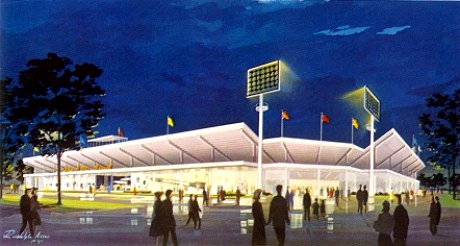 |
By Autumn of 1963, the plans for a permanent
Assembly Pavilion to be built by the Parks Department were replaced
by a new concept for an open-sided geodesic dome structure. Now
called The
World's Fair Pavilion, plans still called for this structure
to seat 2,000 persons with dressing room facilities and lighting
for television broadcasting. This pavilion, during the run of
the Fair in 1964, hosted many of the Olympic Trials held at the
Fair. In 1965, the pavilion's name was changed to The Churchill Center and hosted a major exhibition
on memorabilia from the estate of the late Winston Churchill.
ABOVE: Artist's rendering of The
World's Fair Pavilion. The geodesic dome structure replaced the
design for the Assembly Pavilion. BELOW: Aerial view of World's
Fair site construction in Autumn, 1963, shows progress on The
Arena (upper left corner of the photo).
|
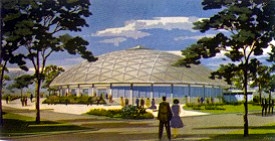
|
Source: (Both)
NY World's Fair Corporation Progress Report #9, September 26,
1963
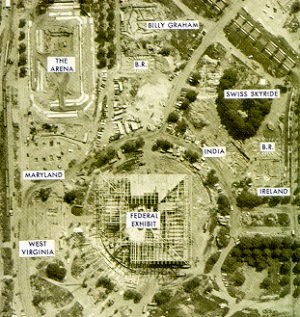 |
Good progress had also been made toward
the construction of The Arena, as The Assembly Area was now being
called. Plans called for a concrete stadium with seating for
15,000 for athletic events and 3,000 additional seats for stage
shows. The stage would move automatically from the side to the
center of the stadium as needed. Lighting would be provided for
evening as well as daylight events.
As the Fair's opening neared, the Singer
Sewing Company agreed to host the operation of the facility during
the run of the Fair and sponsored a major corporate exhibit in
the stadium's entrance hall. Appropriately, the stadium was renamed
The Singer Bowl.
BELOW: Aerial view of World's
Fair site construction taken in Winter, 1964, shows progress on
The Arena (large white expanse to the right of the box-like Federal
Pavilion, near the center top of the photo).
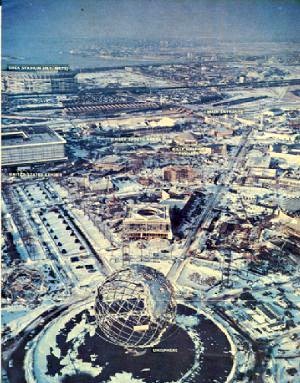 |
|